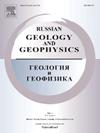Differentiation of Lamproitic Magma: Case Study of Mesozoic High-K Dikes of the Ryabinovyi Massif (Central Aldan)
IF 1
4区 地球科学
Q3 GEOSCIENCES, MULTIDISCIPLINARY
引用次数: 0
Abstract
––Studies of the mineral–petrographic and geochemical compositions of high-potassic lamprophyric dikes of the Tobuk complex, manifested at the Ryabinovyi plutonic massif (Central Aldan Mesozoic magmatic province, Russia), have shown that these dikes compose a single fractionation series formed from a high-Mg lamproitic parental melt in an intermediate chamber. The composition of the rocks ranges from olivine–diopside–phlogopite and diopside–phlogopite lamproites through minettes to microsyenites and syenite–porphyry. Early crystallization of high-Mg olivine and chromite in an intermediate chamber could produce cumulative dunites similar to those of the Inagli intrusion. Crystallization of olivine and chromite was followed by cotectic crystallization of olivine and clinopyroxene, then that of clinopyroxene and phlogopite, and, finally, eutectic crystallization of Na-rich clinopyroxene, phlogopite, and K-feldspar. Crystallization and gravitational differentiation of lamproitic melt was complicated by silicate–carbonate immiscibility, which is texturally manifested in minettes as carbonate–silicate globules and interstitial calcium and magnesium carbonates. Furthermore, compositional zoning of Sr in apatite and Ba in phlogopite and K-feldspar is considered to have resulted from the immiscibility. Separation of the carbonate–fluorite melt fraction might have led to formation of the carbonatite and fluorite–carbonatite schlieren and gangues which have been described in drill cores from the Ryabinovyi massif. In most of the geochemical and mineralogic features, the Ryabinovyi massif lamproites are similar to the low-Ti lamproites of the Mediterranean postcollisional belt and northern Vietnam and differ from typical high-Ti within-plate lamproites.褐铁矿岩浆分异:Ryabinovyi地块(阿尔丹中部)中生代高K峰的案例研究
--对表现在Ryabinovyi深成岩丘(俄罗斯中奥尔丹中生代岩浆省)的托布克复合体高钾长岩尖晶石的矿物岩石学和地球化学成分的研究表明,这些尖晶石组成了一个单一的分馏系列,由中间腔中的高镁长岩母熔体形成。岩石成分从橄榄石-斜长石-辉长岩和斜长石-辉长岩灯石到辉绿岩,再到微闪长岩和正长岩-斑岩。高镁橄榄石和铬铁矿在中间腔的早期结晶可产生与伊纳格里侵入体类似的累积云英岩。橄榄石和铬铁矿的结晶之后是橄榄石和霞石的共晶,然后是霞石和辉石的共晶,最后是富含 Na 的霞石、辉石和 K 长石的共晶。硅酸盐-碳酸盐的不溶性使灯盏石熔体的结晶和重力分化变得复杂,这种不溶性在矿斑中的纹理表现为碳酸盐-硅酸盐球和间隙碳酸钙和碳酸镁。此外,磷灰石中的 Sr 以及辉石和 K 长石中的 Ba 的成分分带也被认为是不溶性造成的。碳酸盐-萤石熔体部分的分离可能导致了碳酸盐岩和萤石-碳酸盐岩裂隙及甘沟的形成,这些在里亚宾诺维地块的钻探岩芯中都有描述。在大多数地球化学和矿物学特征方面,Ryabinovyi 地块的萤石岩与地中海碰撞后带和越南北部的低钛萤石岩相似,而与典型的板内高钛萤石岩不同。
本文章由计算机程序翻译,如有差异,请以英文原文为准。
求助全文
约1分钟内获得全文
求助全文
来源期刊

Russian Geology and Geophysics
地学-地球科学综合
CiteScore
2.00
自引率
18.20%
发文量
95
审稿时长
4-8 weeks
期刊介绍:
The journal publishes original reports of theoretical and methodological nature in the fields of geology, geophysics, and geochemistry, which contain data on composition and structure of the Earth''s crust and mantle, describes processes of formation and general regularities of commercial mineral occurrences, investigations on development and application of geological-geophysical methods for their revealing. As to works of regional nature, accelerated publication are available for original papers on a variety of problems of comparative geology taking into account specific character of Siberia, adjacent Asian countries and water areas. The journal will also publish reviews, critical articles, chronicle of the most important scientific events, and advertisements.
 求助内容:
求助内容: 应助结果提醒方式:
应助结果提醒方式:


